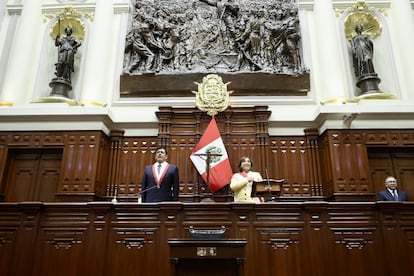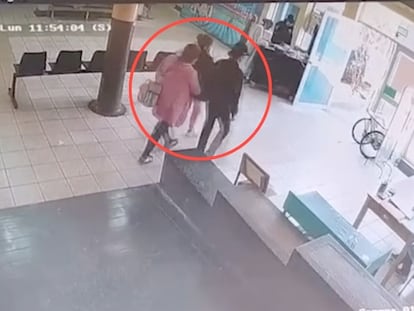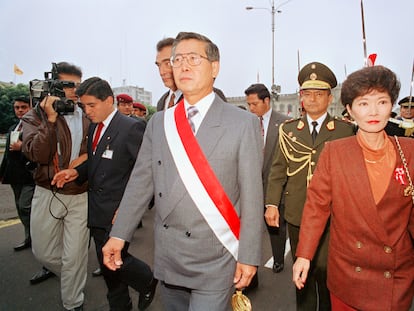Peru: A country stuck in crisis
This week marks the one-year anniversary since former President Pedro Castillo — now imprisoned — attempted to seize power in a ‘self-coup.’ Instability continues to reign in the South American country, which has had four presidents over the last four Christmases

Pedro Castillo’s political suicide occurred on Wednesday, December 7, 2022, a few minutes before noon. The school teacher and union leader had been in the presidential palace for a year-and-a-half, plagued by corruption investigations and low approval ratings.
That afternoon, he had to appear in Congress to face his third impeachment vote. But in an unexpected act — which his lawyers and supporters refuse to call a self-coup — he gave a televised message to the nation. With an agitated voice and trembling hands, he dissolved Congress, decreed an emergency government and established a nationwide curfew.
This Thursday will mark one year since that moment. Peru, however, still remains mired in crisis.
The widespread fear that resulted from Castillo’s announcement lasted only for a brief moment. Lacking the support of the Armed Forces, Castillo fled the palace soon after his address. He was detained by his own bodyguards while heading to the Embassy of Mexico in search of asylum. The Congress quickly impeached him for the charge of “moral incapacity.” Within three hours, his vice-president — Dina Boluarte, a lawyer and former civil servant — was sworn in, becoming the first woman to govern Peru. “My first invocation is to call for the broadest kind of unity and dialogue,” she said, upon assuming the position.
Boluarte was expected to oversee a brief transitional government and call for general elections. However, she gave no signs of doing this, which sparked political tension.
Castillo’s supporters began to express their anger at the former VP. She had broken her promise: on December 7, 2021 — exactly one year before Castillo’s impeachment — Boluarte had declared, during a rally: “If they impeach [Castillo], I’ll go with him.” This was clearly just a statement for the crowd. Peruvian political scientist Eduardo Dargent summarizes her change of heart in a sentence: “She didn’t understand the historic nature of the moment.”
Those who had placed their trust in Castillo took to the streets continuously for the next three months. The protests emerged from Castillo’s strongholds in the Southern Andes, from the most impoverished regions, which have long been forgotten by the government in Lima. They moved to the capital, while Boluarte’s administration entrenched itself and implemented a repressive policy of law enforcement. According to the Ombudsman’s Office, 68 people lost their lives during the protest (49 of them civilians, the rest members of the National Police and Armed Forces) due to fatal injuries from projectiles, bullets and tear gas bombs.
Various international organizations have issued several reports condemning the murders. “It could be described as a massacre… There was disproportionate, indiscriminate and lethal use of force,” stated the Inter-American Court of Human Rights. Human Rights Watch, for its part, has pointed out that “extrajudicial and arbitrary executions were committed” and has denounced “possible negligence and even complicity” on the part of the Boluarte administration in the face of the abuses. The president, meanwhile — far from admitting responsibility — has blamed the protesters. This past September, she said: “Those who killed our brothers in those violent demonstrations were [protesters] themselves… [They] wanted to subdue a constitutional government, a democratic government.”
Political analysts acknowledge Boluarte’s capacity for survival. She has managed to remain in power despite not having the support of the population, nor a bloc in Congress. A survey by polling firm Datum reveals that, last month, the president reached her peak disapproval rating: 84% of Peruvians are not satisfied with her tenure. Across the board, there’s deep distrust in officials, public institutions and political parties. The disapproval rating of Alberto Otárola — the prime minister and second-most visible figure in the government — stands at 74%, according to a survey from November, by the polling firm Ipsos. According to this same study, the president of Congress — Alejandro Soto — registers similar levels of discontent, with an approval rating of only 10%. Congress as a whole competes with Boluarte when it comes to public resentment, with 82% of Peruvians opposed to the tenure of parliamentarians, who have rejected early elections on repeated occasions. They are currently scheduled for 2026.

Over the past 12 months, Peru’s diplomatic relations with several countries in Latin America have been characterized by tension and rudeness. The long tradition of maintaining bilateral relations with Mexico, Colombia and Honduras has been reduced to chargé d’affaires, as Boluarte announced the definitive withdrawal of Peru’s ambassadors from the three countries, due to a series of disagreements with their presidents. Mexican President Andrés Manuel López Obrador refused to recognize her inauguration and has called her a “spurious president.” The fracture has been such that, this past August, Mexico transferred the pro-tempore presidency of the Pacific Alliance to Chile for a month, to avoid the direct protocol with Peru.
In the second half of 2023, the executive branch of the Peruvian government set out to cover its weakened image abroad through Boluarte’s foreign travel. Through a judicial ruling, she obtained authorization to govern from abroad during these trips, as she doesn’t have a vice-president who can attend to her duties in her absence. His first appearance abroad was at the Amazon Summit in Belém do Pará, Brazil, in the eighth month of her mandate. However, the most embarrassing chapter happened at the beginning of November, when she announced a bilateral meeting with Joe Biden… a meeting that never appeared on the agenda of the president of the United States. An attempt was made to salvage the situation with some photos of Boluarte with Biden in the hallways of the White House. Still, the event triggered the resignation of Minister of Foreign Affairs Ana Cecilia Gervasi.
At the end of October, Alex Contreras — the minister of Economy and Finance — admitted that Peru is in an economic recession, after having denied this reality in previous months. It’s estimated that the country’s GDP will close the fiscal year with a decrease of 0.2%, thus making 2023 the worst year since 1999, without taking the pandemic into account. In September, the Peruvian economy contracted by 1.29%, completing five months of decline. Social upheaval, inflation and the issues caused by the El Niño phenomenon have all contributed to this. Citizen insecurity is another pending issue for the government: according to Datum, 94% of Peruvians indicate that the state of emergency that has been imposed in certain districts of Lima and in the provinces hasn’t worked.
The most recent crisis occurred last week, as Attorney General Patricia Benavides has been accused of leading an alleged criminal organization, along with her advisors and a handful of congresspeople from different parties. Subsequently, on Monday, November 27, Benavides filed a constitutional accusation against President Boluarte, Prime Minister Otárola and other members of the cabinet, for the crime of homicide in the case of the deaths of the demonstrators.
César Hildebrandt — a prominent Peruvian journalist — has denounced this accusation by the attorney general as having come too late. He explains it like this: “Nobody believes that Benavides has developed a sense of justice just hours after being denounced as the leader of a criminal organization. Her maneuver is useless. She reported her partner (Boluarte) to see if she could save her skin… and her partner then asked for her resignation, to see if she could cleanse herself in the process. They’re both of the same ilk.”
“Instability” and “permanent crisis” are two definitions that tend to be thrown around to describe the national reality of this ungovernable country. Memes have also been widely-utilized. Whenever December arrives, one of them spreads through social media. The latest one reads: “Peruvians always celebrate Christmas with a new president.” Indeed, as if it were a gift from Santa. In the last four years, no president has survived Christmas Eve. In 2019, the head of state was Martín Vizcarra, who took over after the resignation of Pedro Pablo Kuczynski. In 2020, it was Francisco Sagasti (after five days of Manuel Merino) and, in 2021, Pedro Castillo rang in the new year. By 2022, it was Dina Boluarte.
In the presidential palace, they’ve lit candles to stop the trend. As of now, the star on the tree is still missing.
Sign up for our weekly newsletter to get more English-language news coverage from EL PAÍS USA Edition
Tu suscripción se está usando en otro dispositivo
¿Quieres añadir otro usuario a tu suscripción?
Si continúas leyendo en este dispositivo, no se podrá leer en el otro.
FlechaTu suscripción se está usando en otro dispositivo y solo puedes acceder a EL PAÍS desde un dispositivo a la vez.
Si quieres compartir tu cuenta, cambia tu suscripción a la modalidad Premium, así podrás añadir otro usuario. Cada uno accederá con su propia cuenta de email, lo que os permitirá personalizar vuestra experiencia en EL PAÍS.
¿Tienes una suscripción de empresa? Accede aquí para contratar más cuentas.
En el caso de no saber quién está usando tu cuenta, te recomendamos cambiar tu contraseña aquí.
Si decides continuar compartiendo tu cuenta, este mensaje se mostrará en tu dispositivo y en el de la otra persona que está usando tu cuenta de forma indefinida, afectando a tu experiencia de lectura. Puedes consultar aquí los términos y condiciones de la suscripción digital.
More information
Archived In
Últimas noticias
Most viewed
- Sinaloa Cartel war is taking its toll on Los Chapitos
- Oona Chaplin: ‘I told James Cameron that I was living in a treehouse and starting a permaculture project with a friend’
- Reinhard Genzel, Nobel laureate in physics: ‘One-minute videos will never give you the truth’
- Why the price of coffee has skyrocketed: from Brazilian plantations to specialty coffee houses
- Silver prices are going crazy: This is what’s fueling the rally











































